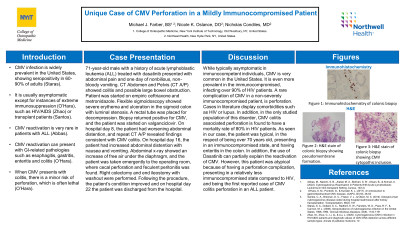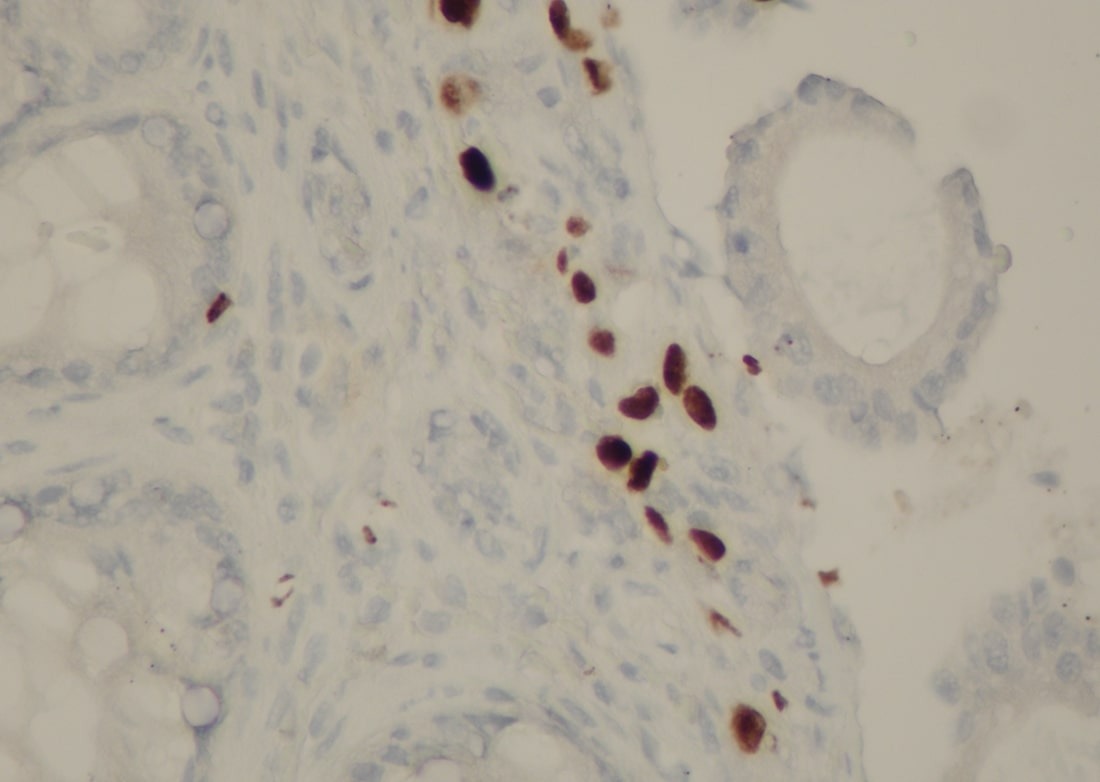Sunday Poster Session
Category: Colon
P0220 - Unique Case of CMV Perforation in a Mildly Immunocompromised Patient
Sunday, October 22, 2023
3:30 PM - 7:00 PM PT
Location: Exhibit Hall

Has Audio

Michael J. Farber, BS
NYIT College of Osteopathic Medicine
Glen Head, NY
Presenting Author(s)
Michael J. Farber, BS1, Nicole K. Oslance, DO2, Nicholas Condiles, MD3
1NYIT College of Osteopathic Medicine, Glen Head, NY; 2Northwell Health, New York, NY; 3Northwell Health, Manhasset, NY
Introduction: Cytomegalovirus (CMV) infection is most frequently seen in highly immunocompromised patients. Associated perforation, though exceedingly rare, requires emergent surgery and is highly lethal. Here we report a case of a patient without severe immunocompromisation who developed a perforation secondary to CMV.
Case Description/Methods: 71-year-old male with a history of acute lymphoblastic leukemia (ALL) treated with dasatinib presented with abdominal pain and one day of nonbilious, non-bloody vomiting. CT Abdomen and Pelvis (CT A/P) showed colitis and possible large bowel obstruction. Patient was started on empiric ceftriaxone and metronidazole. Flexible sigmoidoscopy showed severe erythema and ulceration in the sigmoid colon with luminal stenosis. A rectal tube was placed for decompression. Biopsy returned positive for CMV (Figure 1), and the patient was started on valganciclovir. On hospital day 8, the patient had worsening abdominal distention, and repeat CT A/P revealed findings consistent with CMV colitis. On hospital day 16, the patient had increased abdominal distention with nausea and vomiting. Abdominal x-ray showed an increase of free air under the diaphragm, and the patient was taken emergently to the operating room, where cecal perforation and feculent peritonitis was found. Right colectomy and end ileostomy with washout were performed. Following the procedure, the patient’s condition improved and on hospital day 22 the patient was discharged from the hospital.
Discussion: While typically asymptomatic in immunocompetent individuals, CMV is very common in the United States. It is even more prevalent in the immunocompromised, infecting over 90% of HIV patients. A rare complication of CMV in a non-severely immunocompromised patient, is perforation. Cases in literature display comorbidities such as HIV or lupus. In addition, in the only studied population of this disorder, CMV colitis associated perforation is found to have a mortality rate of 80% in HIV patients. As seen in our case, the patient was typical, in the respect of being over 70 years old, presenting in an immunocompromised state, and having enteritis in the colon. In addition, the use of Dasatinib can partially explain the reactivation of CMV. However, this patient was atypical because of having a perforation complication, presenting in a relatively less immunocompromised state compared to HIV, and being the first reported case of CMV colitis perforation in an ALL patient.

Disclosures:
Michael J. Farber, BS1, Nicole K. Oslance, DO2, Nicholas Condiles, MD3. P0220 - Unique Case of CMV Perforation in a Mildly Immunocompromised Patient, ACG 2023 Annual Scientific Meeting Abstracts. Vancouver, BC, Canada: American College of Gastroenterology.
1NYIT College of Osteopathic Medicine, Glen Head, NY; 2Northwell Health, New York, NY; 3Northwell Health, Manhasset, NY
Introduction: Cytomegalovirus (CMV) infection is most frequently seen in highly immunocompromised patients. Associated perforation, though exceedingly rare, requires emergent surgery and is highly lethal. Here we report a case of a patient without severe immunocompromisation who developed a perforation secondary to CMV.
Case Description/Methods: 71-year-old male with a history of acute lymphoblastic leukemia (ALL) treated with dasatinib presented with abdominal pain and one day of nonbilious, non-bloody vomiting. CT Abdomen and Pelvis (CT A/P) showed colitis and possible large bowel obstruction. Patient was started on empiric ceftriaxone and metronidazole. Flexible sigmoidoscopy showed severe erythema and ulceration in the sigmoid colon with luminal stenosis. A rectal tube was placed for decompression. Biopsy returned positive for CMV (Figure 1), and the patient was started on valganciclovir. On hospital day 8, the patient had worsening abdominal distention, and repeat CT A/P revealed findings consistent with CMV colitis. On hospital day 16, the patient had increased abdominal distention with nausea and vomiting. Abdominal x-ray showed an increase of free air under the diaphragm, and the patient was taken emergently to the operating room, where cecal perforation and feculent peritonitis was found. Right colectomy and end ileostomy with washout were performed. Following the procedure, the patient’s condition improved and on hospital day 22 the patient was discharged from the hospital.
Discussion: While typically asymptomatic in immunocompetent individuals, CMV is very common in the United States. It is even more prevalent in the immunocompromised, infecting over 90% of HIV patients. A rare complication of CMV in a non-severely immunocompromised patient, is perforation. Cases in literature display comorbidities such as HIV or lupus. In addition, in the only studied population of this disorder, CMV colitis associated perforation is found to have a mortality rate of 80% in HIV patients. As seen in our case, the patient was typical, in the respect of being over 70 years old, presenting in an immunocompromised state, and having enteritis in the colon. In addition, the use of Dasatinib can partially explain the reactivation of CMV. However, this patient was atypical because of having a perforation complication, presenting in a relatively less immunocompromised state compared to HIV, and being the first reported case of CMV colitis perforation in an ALL patient.

Figure: Figure 1: colonic biopsy
Disclosures:
Michael Farber indicated no relevant financial relationships.
Nicole Oslance indicated no relevant financial relationships.
Nicholas Condiles indicated no relevant financial relationships.
Michael J. Farber, BS1, Nicole K. Oslance, DO2, Nicholas Condiles, MD3. P0220 - Unique Case of CMV Perforation in a Mildly Immunocompromised Patient, ACG 2023 Annual Scientific Meeting Abstracts. Vancouver, BC, Canada: American College of Gastroenterology.
